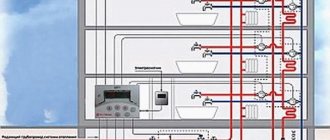Battery in an apartment: whose property?
Government Decree No. 491 of August 13, 2006 determined the composition of property that is considered common. According to this regulatory act, the common property of an in-house heating system includes:
- risers;
- heating elements;
- control and shut-off valves;
- collective heat metering devices;
- other equipment located on these networks.
However, when the need arises to change the batteries in an apartment (especially in a privatized one), both the owner and the management company interpret the legislation in their own interests. Due to regular judicial appeals, the need arose to clarify the normative act.
To clarify the controversial situations, the Ministry of Regional Development of the Russian Federation sent letter No. 6037-RM/07 dated April 4, 2007, in which batteries in apartments are recognized as included in the common property of the building. Of course, it is not in the interests of the management company to convey this information to the owners of privatized apartments. Therefore, homeowners are often forced to replace the battery in their apartment at their own expense.
Heating radiators in the entrance and missing services
2.6.4. The schedule for preparing the housing stock and its engineering equipment for operation in winter conditions is drawn up by the owner of the housing stock or the organization for its maintenance and approved by local governments
based on the results of the spring inspection and deficiencies identified over the past period.
As for the installation of heating systems in entrances (batteries), this relates to the responsibility of the management company for the maintenance and repair of common areas, and the presence of heating is mandatory for a residential premises in order to meet its purpose. Residents, as a rule, pay for this on an ongoing basis on a monthly basis (you can see it in your receipts). As for the installation of windows and doors in winter, the actual period for carrying out such work is one day from the date of receipt of the application. According to these actions of the Criminal Code, including regarding the collection of funds for repairs and installation of heating, you should contact the most competent authority in connection with the amendments to Article 20 of the Housing Code of the Russian Federation - state body. housing supervision - the housing inspection (housing supervision department) of a constituent entity of the Russian Federation with a statement from any tenant with a request to conduct an inspection of such actions and inactions of the Criminal Code. In any case, you will receive a reaction and results of consideration. But even if the decision of the body lived. supervision will not suit you, then you can appeal them in court.
We recommend reading: Sample Certificate that You Did Not Receive Childbirth Benefit
At whose expense are the batteries in the apartment replaced?
Since batteries in an apartment are recognized as the common property of an apartment building, financial responsibility for their replacement or repair falls on the management organization. But there is one nuance here too.
If there is a tap on the branch from the riser of the common house system, with which you can turn off the system in the apartment, then battery maintenance becomes the responsibility of the owner.
In all other cases (it doesn’t matter whether your apartment is municipal or privatized), repairs and replacement of heating equipment are carried out at the expense of the management company. Payment comes from the accounting item “Routine repairs and maintenance of the house.”
Simply put, if your battery is leaking, the management company will replace it. You need to call a specialist, and he is obliged to replace the device free of charge.
It would seem nothing complicated. But in practice, things often happen differently. The management company's employees may say that they do not have a replacement battery. They may offer to repair the old device or install plugs and ask you to wait. This wait usually drags on. Therefore, the owner cannot stand it and purchases a battery at his own expense, because no one wants to freeze in the cold season.
If you nevertheless changed the battery in the apartment at your own expense, you have the right to demand compensation from the management company through the court. However, practice shows that such disputes are rarely resolved in favor of the owner. If you find yourself in this situation, it is advisable to contact a lawyer for professional help.
Dear readers! We cover standard methods for solving legal problems, but your case may be unique. We will help you find a solution to your problem for free
— simply call our legal consultant at:
+7 (499) 391-70-75 (Moscow)
+7 (812) 305-27-75 (Saint Petersburg)
8 (800) 550-97-45 (free call within Russia)
It's fast and free ! You can also quickly get an answer through the consultant form on the website.
If the battery in your apartment bursts
Of course, the owner of the apartment may naively assume that if he did not violate the integrity of the heating pipes and radiators or did not allow them to be misused, then this may mean that he is not to blame... and be mistaken. Even if your battery leaked over time, this means that you did not replace it in a timely manner, and if its malfunction is associated with the actions of third parties, then it is obvious that you were obliged to protect it from this. In any case, no matter what happens to your battery or other elements of the utility networks in your apartment, you will have to restore them yourself. It’s another matter if you manage to prove (possibly in court) the guilt of a third party that the battery burst. For example, the fault may be either the manufacturer or supplier of the defective product, or a neighbor who performed poor heating repairs, or craftsmen who performed unqualified installation. In this number of cases, having properly documented your position, you can not only reimburse your repair costs, but also claim material damage from the culprit (if the flooding of the apartment caused it to your property).
Who owns the batteries in a privatized apartment?
/ Radiators / At whose expense are the heating radiators in the apartment replaced?
The approaching cold season often reveals all the shortcomings of the heating system of a crowded house. Outside equipment is usually repaired and changed based on the collective opinion of the general meeting. What to do with the emergency pipes and at whose expense the heating radiators in the apartments of tenants and owners are replaced, the residents themselves will have to think about. But everything is not so easily resolved if you rely on Russian legislation. Anyway, at whose expense are the heating radiators in the apartment replaced?
The management company refuses to change the batteries. What should I do?
Despite existing legislation and obstacles to replacing batteries yourself without contacting the housing office, dismantling old radiators and installing new radiators on your own is much easier than waiting for these actions from the management organization. When refusing to replace heating appliances, housing office representatives rely on the concept of “balance sheet delineation” of property belonging to the owners and the entire house. According to it, the tenant himself repairs and maintains heating appliances in his personal apartment. But no one can, at will, change the composition of the property belonging to the common house.
Source: https://3dlipz.com/komu-prinadlezhat-batarei-v-privatizirovannoy-kvartire/
Replacing heating appliances in apartments: how not to violate the rights of neighbors?
The heating season has arrived, but not all apartments are warm. Some people complain about lukewarm radiators and wear woolen socks all winter, while others open their windows because of the unbearable heat. Such problems can arise for many reasons, but one of the main ones is a violation of the thermal balance of an apartment building, including due to the unauthorized installation (replacement) of additional battery sections in apartments. What is the thermal balance of a house, why is it disturbed and what can this lead to, as well as what measures need to be taken towards residents found to be thermally unbalanced in the house, we will discuss in this article. The concept of “heat balance of a house” is often used by specialists in the areas of design and maintenance of heating networks of buildings, while no regulatory act contains its specific definition. It seems, based on an analysis of the standards associated with the design of thermal systems of buildings, that the thermal balance of a house is a one-to-one ratio of heat losses in the house and incoming heat. Only with such an ideal ratio (balance) can the required temperature in the house be maintained. In this article, we do not set the main task of describing the technical component of the reasons for temperature changes in various parts of the building, but we still note that when designing a building, the necessary parameters are calculated so as to ensure the normal functioning of the entire house and an uninterrupted, constant and uniform supply of all necessary types of energy.Thermal imbalance of the house can occur due to the installation of additional sections of radiators in apartments or when their configuration is changed. Resolving the issue of classifying radiators located in residents' apartments as the common property of a residential building or defining them as part of the apartment (accessory) is very important in determining the person responsible for their maintenance and operation. Numerous legal disputes related to appealing decisions of the State Housing Inspectorate on the legality of holding organizations serving the housing stock administratively liable for the operation of the heating system of a house are a good example.
Refurbishment of residential premises or violation of the rules for using common property of the house?
For the purposes of this article, we will be interested only in heating elements, heating devices located in apartments, included in the thermal system of the house, which in everyday life are usually called batteries (or radiators).
More information about the reconstruction (re-equipment) of residential premises
HOA chairmen often mistake the replacement of batteries in residential premises for refurbishment and try to restore the previous order of things, that is, oblige apartment owners to bring their residential premises to their original condition, applying the consequences of illegal refurbishment. However, these actions do not comply with the law. In accordance with Art. 25 of the RF Housing Code, reconstruction of residential premises is the installation, replacement or transfer of utility networks, sanitary, electrical or other equipment that require changes to the technical passport of the residential premises. Technical passports of residential premises are documents containing technical and other information about residential premises related to ensuring compliance of residential premises with established requirements. Technical certification is an element of technical accounting of the housing stock. It must be carried out in accordance with paragraph 5 of Art. 19 of the Housing Code of the Russian Federation along with other forms of state accounting of the housing stock.
The technical passport of a residential premises is drawn up in accordance with the Instructions on the accounting of housing stock in the Russian Federation, approved by Order of the Ministry of Land and Construction of Russia dated 08/04/1998 N 37. From the contents of this Instruction (clause 3.16) it follows that the technical passport of a residential premises does not include information about the location and even about the presence of heating appliances located in the residential premises: pipelines for cold and hot water, sewerage, heating, gas, etc., as well as central heating radiators are not shown on floor plans.
Thus, replacing or moving heating devices or changing their configuration does not require changes to the technical passport and cannot be considered as a refurbishment of a residential premises. Accordingly, it is impossible to apply to the actions of the owners of residential premises the consequences of unauthorized reconstruction, which consist in forcing them to bring the residential premises to their original condition.
Are heating appliances in apartments common property?
Radiators are part of the common property of an apartment building, despite the fact that they are located in apartments owned by specific individuals. This conclusion follows from clause 6 of the Rules for the maintenance of common property (approved by Decree of the Government of the Russian Federation of August 13, 2006 N 491). Please note that the legislator included a description of the composition of the in-house heating system in a separate paragraph, while the description of the in-house engineering systems of cold and hot water supply and gas supply was combined in paragraph 5. This was done in order to indicate the specifics of the heating system of the house and separate it from other engineering systems.
Thus, clause 5 of the Rules for the Maintenance of Common Property stipulates that the common property includes in-house engineering systems of cold and hot water supply and gas supply, consisting of risers, branches from the risers to the first disconnecting device located on the branches from the risers, the specified disconnecting devices, collective (common house) metering devices for cold and hot water, the first shut-off and control valves on the branches of the intra-apartment wiring from the risers, as well as mechanical, electrical, sanitary and other equipment located on these networks. And in paragraph 6, the legislator indicated that the common property also includes an intra-house heating system, consisting of risers, heating elements, control and shut-off valves, collective (common house) heat energy metering devices, as well as other equipment located on these networks. Unlike clause 5, clause 6 does not indicate the first shut-off devices, the first shut-off and control valves, that is, the boundaries of the parts of the heating system are not indicated, which applies to the common property of the house and to the individual property of its residents.
This is due to the fact that, unlike water supply and gas supply systems, the heating system of a house is uniform for the entire apartment building and is intended not only for heating any room, but also for transporting heat throughout the apartment building, including to other apartments.
In judicial practice, the issue of the legality of classifying heating appliances as the common property of an apartment building was considered. By the decision of the Supreme Court of the Russian Federation of September 22, 2009 N GKPI09-725, left unchanged by the Decision of the Supreme Court of the Russian Federation of November 24, 2009 N KAS09-547, clause 6 of the Rules for the maintenance of common property in terms of classifying heating devices located in the owner’s apartment as the common property of an apartment building, it was recognized as not contrary to current legislation.
So, speaking about heating devices located in apartments, we are dealing with the common property of an apartment building. As you know, the common property of the house belongs to all owners on the right of common shared ownership and, accordingly, its fate is determined by the decision of the general meeting of owners of the premises (Article 44 of the Housing Code of the Russian Federation). However, there is no uniformity in law enforcement practice.
Sometimes, in order to understand that heating devices belong to the common or, conversely, personal property of the apartment owner, a construction and technical examination should be assigned, during which the expert is asked the following questions: - are the heating elements of the intra-house system intended to serve more than one room in a given house? heating systems located in a (specific) apartment; — how more than one room in a given house is serviced by heating elements located in the apartment.
The expert should give answers to these questions based on the technical features of the interaction of heating elements in a separate apartment with other rooms in the house.
What the HOA chairman should know
Identification of apartments with unauthorized installation of heating devices
It is absolutely logical and understandable that homeowners want to improve their living conditions. Since the radiators are located in the apartments of the owners, many consider them to be their personal property, so they replace them or increase the number of their sections, which is dictated by physical wear and tear and insufficient heat supply to the apartment. At the same time, residents of the building very often ask the chairmen of the HOAs questions related to violations of the temperature regime in apartments during the heating season. The workload of the State Housing Inspectorate on complaints from citizens due to the lack of proper temperature in apartments during the heating season is also increasing. In this regard, the chairmen of the partnerships need to know and promptly take all measures to prevent conflict situations with residents in connection with the violation of the thermal balance of the house, as well as identify those problem apartments in which radiators were unauthorized installed (replaced), for further work to restore the thermal balance home balance.
An appeal by the chairman of the HOA to the State Housing Inspectorate with a complaint against a citizen will not do any good. The Administrative Code provides for the responsibility of a citizen - owner of a premises only for damage to residential buildings, residential premises, as well as damage to their equipment, unauthorized reconstruction of residential buildings and (or) residential premises (Article 7.21 of the Code of Administrative Offenses of the Russian Federation). However, as we found out above, when replacing heating appliances, the provisions of housing legislation on the refurbishment of residential premises do not apply.
Moreover, when the chairman of the HOA contacts the State Housing Inspectorate, there may be a risk of an unscheduled inspection of the activities of the partnership itself. Thus, a service organization may be held liable under Art. 7.22 of the Code of Administrative Offenses of the Russian Federation with the imposition of a fine in the amount of 40,000 to 50,000 rubles. Paying fines means an additional burden on the HOA, and therefore a decrease in funds that could be used for the maintenance and repair of an apartment building.
In order to avoid bringing the HOA itself to administrative responsibility, it is necessary to independently identify problem apartments and restore the disturbed thermal balance of the house. Every year at the beginning of the heating season, the correct distribution of the coolant throughout the heating systems, including individual risers, is checked. The distribution of the coolant should be carried out according to the temperatures of the returned (return) water according to the data of the design or commissioning organization (clause 5.2.7 of the Rules for the operation of the housing stock (Rules and norms for the technical operation of the housing stock, approved by Resolution of the Gosstroy of Russia dated September 27, 2003 N 170).
As part of this check, it is possible to identify facts of unauthorized installation (replacement) or changes in the configuration of batteries in the apartment, which may cause changes in the temperature regime in other residential premises during the heating season.
From the practice of the chairmen of some HOAs, it follows that when preparing for the heating season, heat supply organizations conduct a random survey of apartments to identify unauthorized installed (replaced) radiators. If they are detected, the certificate of readiness of the house for the heating season is not signed. Of course, heat will be supplied to the apartments at the beginning of the heating season, since this is the responsibility of the heating supply organization, and it has no right to neglect it. However, an unsigned act further relieves the heat supply organization of any responsibility in the event of a violation of the quality of heat supply due to the presence of batteries installed in violation of the design. Thus, heat supply organizations delegate the decision on restoring the heat balance of the house to the HOA, which means that it remains the only responsible person if the heat balance of the house is disturbed.
Be that as it may, the Rules for the operation of housing stock clearly establish the obligation of the service organization to control the unauthorized increase or replacement of heating devices inside apartments. Thus, according to clause 5.2.1 of this document, the operation of the central heating system of residential buildings must ensure, among other things, the elimination of overly installed heating devices and the installation of additional ones in certain rooms that are lagging behind in temperature conditions.
This means that the HOA has the opportunity to dismantle excessively installed radiators in apartments. Of course, in practice, difficulties may arise with the implementation of this power, since not a single owner will agree to dismantle the batteries in his apartment of his own free will. The only way to solve this problem is to go to court with a claim to force the homeowner to dismantle excessively installed battery sections due to their unauthorized installation (violation of the procedure for using common property). Let us recall that since batteries are common property, the decision to increase the composition of the latter is made by a qualified majority of votes at a general meeting of homeowners (Articles 44, 46 of the Housing Code of the Russian Federation).
Information work with residents
I would like to note that the chairmen of the HOA need to conduct information work with the residents of the building. As a rule, many residents do not know at all where to go if they need to replace the batteries in their apartment, what to do and what to pay attention to, and independently dismantle and subsequently install new radiators, which can subsequently lead to thermal imbalance in the house and violation of rights and the legitimate interests of their neighbors and, in the worst case, an emergency situation for which the HOA will have to answer (clause 1.7.5 of the Rules for the operation of the housing stock).
Clause 5.2.5 of the Rules for the Operation of the Housing Stock establishes the authority of service organizations to control the installation of batteries: increasing the surface area or number of heating devices without the special permission of the organization for servicing the housing stock is not allowed. The HOA has the right to prohibit the installation (replacement) of heating devices in an apartment if they do not comply with the heating devices provided for in the project. Based on this, residents should be informed about the need to coordinate with the service organization (in our case, the HOA) for the installation (replacement) of batteries in their apartment.
In this situation, the chairman should pay attention to what exactly needs to be agreed upon by the owner of the premises: - replacement of “original” batteries with radiators of the same type (similar to those installed during the construction of the house); - replacement of radiators with radiators of a different type (different from those provided for by the building design), including changing the configuration (number of sections) of radiators; - transfer of batteries.
In the first case, the apartment owner has the right to install batteries similar to those provided for in the project without obtaining special permission from the service organization (HOA). However, in our opinion, he should clarify which batteries correspond to the project and notify the HOA about replacing the batteries in order to avoid problems in the future, including emergency situations.
In the following two cases, the chairman of the HOA, who does not have special technical knowledge, when deciding on the technical possibility of replacing radiators with radiators of a different type (different from those provided for by the building design), including changing the configuration (number of sections) or when When transferring batteries, you should seek the help of a specialist who will determine the feasibility of installing certain devices. At the same time, it seems that replacing “original” batteries with radiators of the same type (similar to those used in the construction of the house) is possible without additional consultation with a technical specialist, since the material of the heating devices does not change, and, accordingly, the load on the heating system of the house does not change.
The question arises about payment for the services of a technical specialist. At whose expense will an examination be carried out to determine the compliance of heating devices with the design and the possibility of installing them in an apartment without damaging the heating system of the house? It is obvious that in this case, conflict situations may arise. However, it seems that the owner of the apartment in which he is going to replace the batteries should bear the costs, since it is he who takes the initiative to change the heating system of the entire house. Replacing batteries with the same number of sections made of materials other than the material of the “original” batteries, or with an increase in their surface area, can lead to the fact that the heating system of the house, designed according to the project for a certain load, will become unbalanced and the temperature load will be unevenly distributed to different parts buildings (apartment by apartment), so carrying out a technical examination will allow you to avoid many problems and lawsuits in the future.
* * *
As you know, it is better to prevent the occurrence of a conflict situation than to understand the reasons for its occurrence after the fact. Preventive measures, information work of chairmen with residents on various issues of the life of the house, including maintaining the thermal balance of the house, will be a good help in ensuring the high-quality operation of an apartment building and comfortable living in it for residents.
Here the chairman can and should act as an assistant and ally, since he is also the owner of the premises in this house and his interests, by definition, are similar to the interests of all other property owners - his neighbors.
Author: E.V. Fomicheva, legal consultant of the Housing Education Foundation “Association of HOAs of Nizhny Novgorod” // “Housing and communal services: accounting and taxation”, 2011, No. 1
Site support
Warmth in our entrances: radiators and radiators
- purpose of houses;
- climatic conditions of the location of residential and technical structures;
- type of radiators;
- material of their manufacture and type of coolant;
- location of devices;
- number of sections in the heating element;
- the degree of insulation of rooms, houses, individual premises, flights of stairs;
- the amount of pressure in the heating system and the ability to withstand pressure by pipes and other elements of the system.
Batteries are traditionally installed under window openings, this is done deliberately to heat the colder air. During the convention, it rises to the ceiling, circulating around the room, cools down, falls down and heats up again. In this way, the premises of the houses are heated. Heating devices are installed under each window of living rooms; it is advisable to make the number of sections equal, then it looks beautiful and heating occurs evenly. The required number of sections per room is calculated, divided by the number of windows, and as a result we obtain the required number of sections per radiator.
We recommend reading: Labor veteran in the Tver region
Is it profitable to install an individual heat meter in an apartment and how to do it correctly
Before installing an individual heat meter in an apartment with central heating, it is necessary to resolve the formal side of the issue by contacting the heat supply organization with a corresponding application. The further procedure in the countries of the former USSR looks almost the same:
Proportionalizers are widely used in Western Europe, but in the post-Soviet space they are not yet in demand due to inconsistency in legislation. However, large cities have already gained some experience in the successful use of such heat meters, as described in the video:
01 Feb 2020 etolaw 449
Share this post
- Related Posts
- How long does it take for a house to be renovated?
- How much can I get back for an apartment? 13
- What Documents Are Needed for Registration of Ownership of a Municipal Apartment
- Settlement center to find out the debt on utility bills Murmansk
Batteries in the entrance
How to file a complaint and compensation for damage to the housing office due to the fact that they removed the battery in the entrance and left hooks on which I hit my shoulder and now it hurts for a month. I went to the doctor and prescribed ointments and paid physical therapy. cabinet. Is it possible for the housing department to pay the costs? I look forward to your answer.
Our management company installed an overpriced battery in our building in the entrance. I myself saw the estimate for working with the material, it cost almost 17 thousand rubles, the battery was welded from simple pipes. Although if I had bought it in a store it would have been much cheaper. And most importantly, the management company did not ask the residents whether these batteries were needed in the entrance; there was no meeting of any kind. And they did it at our expense. How can you force them to remove these batteries and what would be the expense of the management company?
Is it necessary to install batteries in the entrance of MKD
“Another thing is that in practice the established temperature regime in public areas is not always observed even now,” says the director of the Contact Center. – Therefore, residents should invite representatives of the management organization, service “05” to record the “underflow” and draw up a report. This will have to be done regularly. In buildings where there are active chairmen of the councils of apartment buildings, this system works. Therefore there is a way out.
In the new heating season, residents of apartment buildings must pay for heating not only apartments, but also common areas (CPAs). Nobody wants to pay considerable sums for this service, because according to SNIP, the optimal temperature in non-residential premises of a house should be 16 degrees. And this is almost fantastic in our conditions.
We recommend reading: How much does it cost to connect a debtor to utilities?









